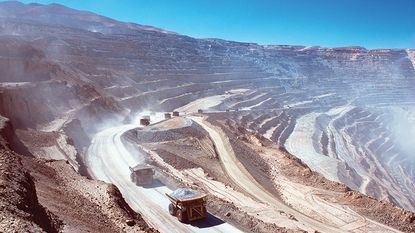Commodity prices are taking a breather
Commodity prices have fallen back after spiking early in the year. Iron ore is down 36% from its March peak, while copper has lost 20% since 1 January. And there could be further falls to come.


Fears of recession “continue to grip commodity markets,” say Goldman Sachs’s analysts in a note. Yet “physical fundamentals signal some of the tightest markets in decades”.
Commodity prices surged earlier this year after Russia’s invasion of Ukraine, but many raw materials have since tumbled back to earth. The price of iron ore is down 36% from its March peak, while aluminium and copper have lost 19% and 20% respectively since 1 January. Wheat futures have returned to pre-invasion levels.
Despite this, the S&P GSCI index, which tracks the prices of 24 major raw materials, has still gained 12% since the start of the year because energy prices remain buoyant. The S&P GSCI Energy sub-index, which tracks global oil and gas prices, is up 23% since 1 January.
Subscribe to MoneyWeek
Subscribe to MoneyWeek today and get your first six magazine issues absolutely FREE

Sign up to Money Morning
Don't miss the latest investment and personal finances news, market analysis, plus money-saving tips with our free twice-daily newsletter
Don't miss the latest investment and personal finances news, market analysis, plus money-saving tips with our free twice-daily newsletter
Supply squeeze could drive commodity prices down further
The prices of oil, metals and agricultural products could yet have further to fall, says Jeffrey Frankel for Project Syndicate. First, global growth – and thus demand for commodities – is being squeezed by China’s slowdown, US rate rises and Europe’s energy crunch. Second, real interest rates are on the rise. There is a “long-established” relationship between higher real rates and lower commodity prices, one reason being that higher rates cause “institutional investors to shift out of... commodities” and into alternatives, such as government bonds.
This summer’s commodity plunge has “reminded us that commodity investing is not for the faint-hearted”, says Tom Stevenson in The Daily Telegraph. Yet for all the current fears about recession, the “underlying driver” of commodity markets is physical supply and demand. Years of “underinvestment in the production of sufficient energy and other resources” mean that supplies of many raw materials are running short.
High energy costs are also squeezing the supply of some metals, says Étienne Goetz in Les Echos. European producers of zinc and aluminium have been forced to cut back production in response to record electricity prices. It takes nearly 15 megawatt hours (MWh) to produce a ton of aluminium, prompting some to joke that the metal is “nothing but solid electricity”.
China's reopening should bolster demand
Commodity prices may be close to a bottom, says Yuhao Fang for Capital Economics. A gradual reopening of China’s economy later this year, combined with a measure of fiscal stimulus, should bolster demand in the world’s most important commodity market. What’s more, “the supply shortages that pushed up prices earlier in the year have not gone away”.
Inventories are at “distressed levels and significantly below five-year averages” for most major commodities, agree James Luke, Malcolm Melville and Dravasp Jhabvala of Schroders. They note that “15% to 25% corrections” of the type experienced in recent months have occurred in previous commodity bull markets. In the long term, the green transition and other climate-change policies could mean we are heading for a “structural” bull market for metals, energy and agriculture, so it might be time to “buy the dip”.

Alex is a member of the UK team at CVC Capital Partners. Prior to joining CVC, Alex worked in the London office of AEA Investors, a mid-market private equity firm. Previously he was part of the UK M&A team at Barclays Capital. Alex holds a BSc in economics from the University of Warwick.
-
-
 Investment trust discounts hit 2008 levels. Here’s how to profit
Investment trust discounts hit 2008 levels. Here’s how to profitInvestment trust discounts have risen to levels not seen since 2008, here are three trusts looking to buy to profit.
By Rupert Hargreaves Published
-
 A luxury stock to buy at a high street price
A luxury stock to buy at a high street priceInvestors wrongly consider Watches of Switzerland a high-street outlet.
By Dr Matthew Partridge Published
-
 Investing in wine: how Cru Wine is reaching new audiences
Investing in wine: how Cru Wine is reaching new audiencesTips Gregory Swartberg, founder of fine wine specialist Cru Wine, talks to Chris Carter about how to start a wine collection
By Chris Carter Published
-
 Small companies with big potential
Small companies with big potentialMichael Taylor of Shifting Shares reviews his 2023 picks and highlights more promising minnows.
By Michael Taylor Published
-
 The MoneyWeek portfolio of investment trusts – July 2023 update
The MoneyWeek portfolio of investment trusts – July 2023 updateTips A decade ago we set up the MoneyWeek portfolio of investment trusts. They remain a compelling long-term bet says Rupert Hargreaves
By Rupert Hargreaves Published
-
 Women lead the way with ethical investments
Women lead the way with ethical investmentsDemand for more ethical investments has soared – and women are more likely to opt for them. Annabelle Williams, personal finance specialist at Nutmeg, takes a look at why.
By Annabelle Williams Published
-
 BoE: Mortgage payments to rise by £220 a month for households
BoE: Mortgage payments to rise by £220 a month for householdsMillions of households can expect a mortgage spike of around £200 a month - and some may even reach a extra £1,000 a month, the Bank of England warns
By Marc Shoffman Published
-
 What happened to Thames Water?
What happened to Thames Water?Thames Water, the UK’s biggest water company could go under due to mismanagement and debt. We look into how the company got itself into this position, and what investors should expect.
By Simon Wilson Last updated
-
 Where to invest in the metals that will engineer the energy transition
Where to invest in the metals that will engineer the energy transitionA professional investor tells us where he’d put his money. This week: John Ciampaglia, manager of the Sprott Energy Transition Materials UCITS ETF.
By Nicole García Mérida Published
-
 How investors can profit from high food prices
How investors can profit from high food pricesThe latest furore over grocery prices will die down, says David Stevenson. But the long-term outlook for soft commodities remains bullish. These are the stocks investors can buy to profit from high food prices.
By David J Stevenson Published









